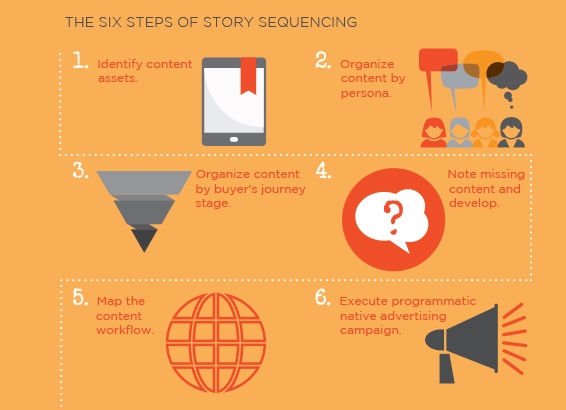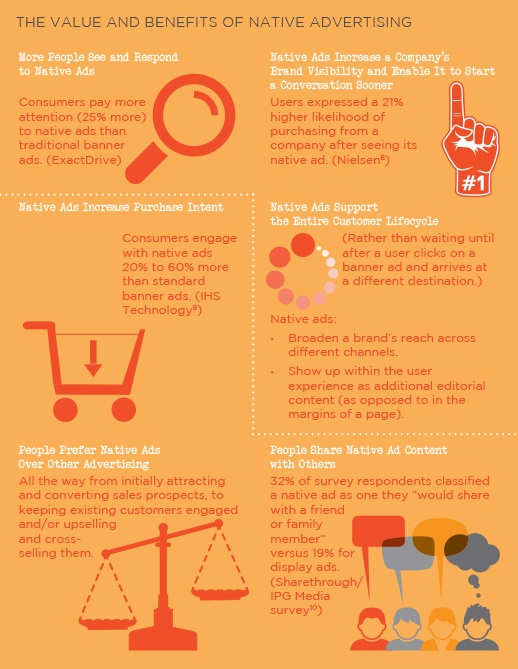We live in a world where everyone and everything does more and more online. It makes sense, then, today’s world of digital advertising is constantly evolving; marketing trends change just as fast as the way consumers engage with digital information changes. Despite ever-evolving trends, one tactic has generated the most hype in the digital space as of late: programmatic advertising.
Topics: Native Advertising, Tracking & Metrics
Publishers and other websites often provide advertisers with a list of metrics by which to judge a native ad’s performance. While helpful, a brand should create its own metrics. Why? Native advertising typically relies on much subtler metrics to prove success than traditional banner ads (as most native ad campaigns seek to understand user attention and time spent with content versus driving immediate conversions).
Topics: Native Advertising, Tracking & Metrics
Regardless of what format a content asset takes (e.g., a blog post, a bylined article, a guide, a white paper, etc.), the actual words, visuals, and other elements constitute the collective message that will be delivered to a target audience. So, it’s important for a brand to prudently craft its messages.
This generally takes the form of aligning content production with each buyer’s journey. This is the exact process marketers take when building out lead nurturing or email drip campaigns. Brands that use marketing automation tools in a robust way should have this done already. If not, appropriate research of the audience, analytics, competitors, media, and trends can help align content to the buyer’s journey.
Topics: Native Advertising, Consumer Journey, Story Sequencing, Best Practices
Believe it or not, native advertising has been around for over 100 years. It has existed in magazines and newspapers, on radio and television, and today, it has become a major distribution channel for many digital media buyers and content marketers, alike.
Media buyers are finding it to be a fruitful alternative to display advertising. Unlike native advertising, display advertising is only a few decades old. However, its effectiveness at driving clicks and engagement has been steadily declining in the last decade. According to Solve Media, a person is more likely to survive a plane crash than click on a banner ad.
Topics: Native Advertising
For those familiar with the terms “programmatic” and “native,” the concept of “programmatic native” probably sounds counterintuitive at first. After all, the success of native advertising relies on its ability to mirror exactly the form and function of its host publisher, while programmatic refers to automated buying and selling of digital ads However, the merging of automation and customization is achievable, and the benefits of doing so can be huge. Programmatic native advertising applies real-time data to individual ads, ensuring that they are placed on relevant and appropriate sites that will enhance the consumer’s experience.
Topics: Native Advertising, Programmatic
Programmatic native advertising supports content marketing. That means, in order to use in-feed native ads to promote a brand or product, a brand must have a solid content and distribution strategy. We’ve observed mistakes some marketers commit seemingly stemming from a misunderstanding of how in-feed native works. The good news is, they're fixable! But first let's acknowledge what goes wrong.
Four major mistakes as follows:
Topics: Native Advertising, Best Practices, Content Marketing
Quality Metrics: How to Determine the Value of Your Native Ad Campaign
We’ve mentioned it before, but we’ll say it again. Native Advertising kicks butt in today’s ever-changing world of online advertising. It’s a tactful way to deliver valuable content—your brand story—to prospective customers, leading to impactful impressions and brand lift. Advertising that’s beneficial to both the consumer and brand? Yeah, that’s pretty powerful. Of course, sponsored content doesn’t automatically guarantee engagement. Creating relevant, meaningful content is only part of the equation. You also need to take a strategic approach by using quality metrics to inform and ultimately define the success of your Native Ad campaign.
Topics: Native Advertising, Tracking & Metrics, Best Practices
Just as five feng shui elements can help you to balance your environment, five native ad elements can help you to place your campaign on the road to success. Native Advertising provides an opportunity to reach, engage and build a relationship with prospects in ways traditional ads simply can’t. Although the nature of native ads is to seamlessly blend in and appear native to the page—hence the name—the goal is to encourage consumer interaction in a less invasive, more impactful way that benefits both the consumer and brand.
Topics: Native Advertising, Best Practices
Ideal for sophisticated media buyers, clever content marketers, and progressive agencies, Storygize integrates with major native ad exchanges to buy programmatically and scale campaigns efficiently. Watch the cool pup show how Storygize helps brands to connect to new audiences, optimize against content engagement, and generate demand with programmatic native advertising.
Topics: Native Advertising, Content Strategy
A conversion funnel is one of the most powerful tools at a content marketer’s disposal. Used in conjunction with buyer personas, conversion funnels create a reliable picture of how a customer feels at each stage of the buyer’s journey. Once a brand knows how their audience feels, it is possible to create content that the audience will care about.
A brand that can provide content that is relevant and interesting to its target audience at every step of the way increases the likelihood of a successful content marketing campaign, and thus a powerful native ad campaign. It is essential that content be mapped appropriately to a conversion funnel to increase the likelihood of the consumer moving to the next step in their journey.
Topics: Native Advertising, Content Strategy, Consumer Journey










